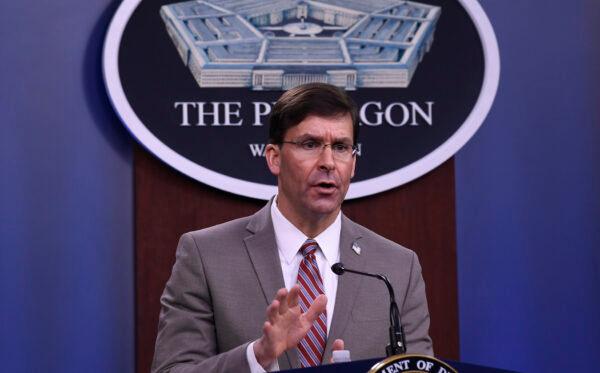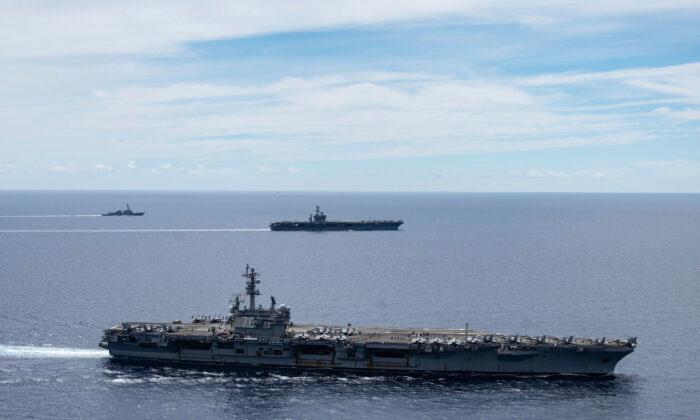The U.S. Navy is “not in search of conflict” as it continues freedom of navigation operations in the South China Sea at a record pace, according to Defense Secretary Mark Esper, who said he hopes to visit his counterpart in China by the end of the year.
Esper outlined the U.S. vision for security in the Indo-Pacific region in a speech on July 22. He said the appetite for multilateral cooperation in the region has grown since the pandemic, and following the recent uptick in Chinese aggression in the region.
Strengthening partnerships in the region is one of three key U.S. strategic goals in the Indo-Pacific, Esper said. The other two are to push back against China’s bullying and coercion of smaller nations, and to ensure that ships and planes are free to operate under international laws and norms in the region, which is a vital area for 80 percent of global trade.
Esper said the U.S. military plans to continue a record-breaking level of exercises in the South China Sea. However, he emphasized that U.S. actions in the region are solely for the purpose of holding China to the rules-based international order.

“I have personally spoken to my PRC counterpart on multiple occasions and before the year is out I hope to visit the PRC for the first time as secretary in order to enhance cooperation on areas of common interest, establish the systems necessary for crisis communications and reinforce our intentions to openly compete in the international system.”
Esper underlined the importance of a statement made last week by the State Department, which for the first time officially rejected Beijing’s major territorial claims in the South China Sea.
He said that the statement “makes clear that the PRC has no right to turn international waters into a zone of exclusion or its own maritime empire.”
The actions of the U.S. military support the policies, he said.
“In 2019, we conducted the greatest number of Freedom of Navigation Operations (FONOPs) in the South China Sea in the 40-year history of the FONOPs program, and we will keep up the pace this year,” he said.
“Additionally, on two occasions earlier this month, two carrier strike groups conducted exercises together in the South China Sea for the first time since 2012: a clear and powerful signal that we will fly, sail, and operate wherever international law allows.”
Esper noted an uptick in aggression by Beijing in the region since the pandemic. However, he said that the pattern of bullying and coercion of other countries has been going on for years.
“It seems your arm gets twisted harder, the smaller the country you are,” he said.

The United States on July 13 formally rejected nearly all of Beijing’s major territorial claims in the South China Sea, as the Trump administration dials up its response to threats posed by the Chinese Communist Party.
“Beijing’s claims to offshore resources across most of the South China Sea are completely unlawful, as is its campaign of bullying to control them,” Secretary of State Mike Pompeo said in a statement at the time.
While U.S. officials have previously described the regime’s activities in the region as “unlawful,” Pompeo’s remarks represent the United States’ official rejection of specific claims made by Beijing, by aligning with a 2016 ruling by an international tribunal. The Philippines had challenged China’s claims in the waterway and brought the dispute to an international court.
That binding decision rejected China’s maritime claims related to the Spratly Islands and neighboring reefs and shoals. The Chinese regime has refused to recognize the ruling.
“The PRC [People’s Republic of China] has no legal grounds to unilaterally impose its will on the region,” Pompeo said.
China, the Philippines, Vietnam, Malaysia, Brunei, and Taiwan have competing claims in the South China Sea. Beijing’s claims are the largest, covering almost all of the waterway. Home to rich fishing grounds and potentially valuable natural resources, the South China Sea is also one of the world’s major shipping routes.





